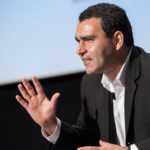If you’re a reader of The Economist, chances are you’re looking forward to the long weekend, not just for the barbecues and beer but also for the opportunity to read this week’s issue from cover to cover and maybe even finish previous editions. Your devotion to this pub, one of the few news magazines that has weathered the digital tsunami, is grounded in a shared appreciation for insightful commentary from a very clear and consistent point-of-view. A point-of-view that just about all news can be interpreted through an economic lens expressed via language that is sharp, sassy and to my ear, singularly British.
For content marketers, the lesson here should be obvious. Without a distinctive brand voice, your content will drown in the 30 trillion pages of content Google indexed last year! One way to overcome this challenge is to partner with a brand that already has a unique voice and a devoted audience. To understand how that works, I talked to Jeff Pundyk VP of Global Integrated Content Solutions at The Economist a few months back. I’m confident you’ll find this interview worth reading before you fire up your next content program. [For more sizzling insights, join Jeff and me at the upcoming Corporate Social Media Summit in NYC June 20-21st.]
Drew: This may seem like a weird question for a content creation company, but do you have a content strategy for marketing The Economist beyond publishing a magazine and ezine?
Our content strategy is simple and basically unchanged since the publication was founded in 1843 — serve the reader first. That’s true whether we’re doing print, film, digital, social, our aps or VR. That may sound obvious, but these days it’s not. Today as the media landscape morphs and as more and more alternatives to media companies emerge — and as the lines between content and marketing blur — readers don’t know who to trust. We build trust and credibility by putting our readers’ interests above our own, by being fully transparent about our commercial relationships, by having a deep understanding of who our audience is and how to serve them uniquely.
Drew: Years ago I used to attend lots of Economist events and they were always excellent. Many times these were centered around a new research study which today would be touted under the content marketing umbrella. Do you still do a lot of events & studies and are these integrated into your overall content creation strategy?
Yes, we do many events and we continue to create sponsored content for our clients. As the traditional advertising business declines, both of these are important services we can provide for our clients. Happily, our readers are very open to the proposition of connecting to our clients through original content — whether that be an event, digital media, or an old-school report — because we have earned their trust and do not violate it.
Drew: With seemingly every brand thinking they need to be in the content creation business, where does that leave a long-time quality content creator like The Economist?
It’s never been a better time to be a company that makes quality content for a quality, global audience. Given all the companies creating content, the question is how do you rise about the noise. Our answer is by creating high-quality work that connects with our audience in ways that nobody else can match.
Drew: I read recently that Meredith made a deal with Georgia Pacific to create a lot of that brand’s content. Are you looking at similar arrangements with marketers?
Yes, we have many clients for whom we create content, and have being doing so for a long time. Some are traditional research programs like you remember and others are more innovative digital projects. Our most well known is probably the program we do with GE, called Look ahead. It’s a three-year program. We create content for this program every day. The content is not about GE but is about topics that GE is associated with — Transportation, Health, Advanced Manufacturing and Energy. It is sponsored content created by a dedicated team of journalists who are separate from Economist journalists. See it here: http://gelookahead.economist.com/
Drew: As a publisher, you know only to well how costly it is to create really high quality content and then build an audience for that content. Do brands really have a chance at getting this done right?
It doesn’t have to be expensive to get started and to start learning what works for you and for your audience. There’s lots of ways to do small, smart experiments that will inform your bigger decisions. Frankly, there is no alternative. The people you are trying to reach have clearly moved beyond the old school marketing-communications tactics. If you don’t find new ways to engage, they will get what they need somewhere else. There’s no shortage of choices.
Drew: What are the most common mistakes you are seeing brands make in the area of content marketing?
There’s a few simple questions anybody creating content should be able to answer:
- Who are you trying to reach?
- What are you trying to get them to do?
- How will you reach them?
- What can you tell them that is distinctive, relevent to them and credible coming from you?
- What does success look like?
Before you start pumping out content, take the time to answer them.
 The presenter spoke with a certainty of a televangelist offering a laundry list of directives to his flock. “Times have changed” he intoned and “marketers must change with it.” “You can’t control the conversation, you have to discover the context, not try to dictate it,” he shouted. “Context is more important than content” was followed by “You are competing for attention against everything.” Heads in the audience were nodding dutifully while I started reaching for my Buzzword Bingo playing card just in case he had more. And he did. But then he said two things that made me laugh out loud, “Only Bozos buy eyeballs” which was followed by “You don’t want to be at the airport when your ship comes in!” Evidently, “TV is dead” and “we’re never going back.”
The presenter spoke with a certainty of a televangelist offering a laundry list of directives to his flock. “Times have changed” he intoned and “marketers must change with it.” “You can’t control the conversation, you have to discover the context, not try to dictate it,” he shouted. “Context is more important than content” was followed by “You are competing for attention against everything.” Heads in the audience were nodding dutifully while I started reaching for my Buzzword Bingo playing card just in case he had more. And he did. But then he said two things that made me laugh out loud, “Only Bozos buy eyeballs” which was followed by “You don’t want to be at the airport when your ship comes in!” Evidently, “TV is dead” and “we’re never going back.” You could say that the three of us were walking to the park, but in truth Pinky was merely along for the ride. Sitting tall in his new chariot, our Frenchie sniffed in the sights as if his ‘hood had been transformed. Hands, those most desired instruments of affection, were suddenly at cheek level, drawn in by his come hither gaze. Few were immune to his entreaties especially his fellow geriatrics who enjoyed comparing heart meds though one contrarian vigorously recommended homeopathic hawthorne with a touch of cayenne. Inured to all but attention, King Pinky was bemused. Thus began our new normal.
You could say that the three of us were walking to the park, but in truth Pinky was merely along for the ride. Sitting tall in his new chariot, our Frenchie sniffed in the sights as if his ‘hood had been transformed. Hands, those most desired instruments of affection, were suddenly at cheek level, drawn in by his come hither gaze. Few were immune to his entreaties especially his fellow geriatrics who enjoyed comparing heart meds though one contrarian vigorously recommended homeopathic hawthorne with a touch of cayenne. Inured to all but attention, King Pinky was bemused. Thus began our new normal. It was one of those rare Los Angeles days — smog free, blue skies and the air was crisp. A perfect set up for what I hoped would be a perfect pitch. We were sitting in a diner right across the street from the bank headquarters in Pasadena and we were the opposite of stressed out. Like well-prepared boxers, we were ready, really ready. We were confident in our strategic sharpness and that we had the big idea. We even had most of the critical tactical details worked out to deliver a successful launch campaign. So when we walked over to the bank about 15 minutes before the appointed hour, witnesses might have seen a slight swagger in our step. Little did we know that our swagger was about to be shattered.
It was one of those rare Los Angeles days — smog free, blue skies and the air was crisp. A perfect set up for what I hoped would be a perfect pitch. We were sitting in a diner right across the street from the bank headquarters in Pasadena and we were the opposite of stressed out. Like well-prepared boxers, we were ready, really ready. We were confident in our strategic sharpness and that we had the big idea. We even had most of the critical tactical details worked out to deliver a successful launch campaign. So when we walked over to the bank about 15 minutes before the appointed hour, witnesses might have seen a slight swagger in our step. Little did we know that our swagger was about to be shattered. With the Empire State Building glowing in the background, I wondered what was on my own horizon that evening. The cocktail party in a chic midtown hotel had just begun, the award-winning CMOs were pouring in and my curiosity was starting to peak. Who were these people? Sure I could read their name badges but what were their stories and more importantly, would I have time to discover them in between the chit chat?
With the Empire State Building glowing in the background, I wondered what was on my own horizon that evening. The cocktail party in a chic midtown hotel had just begun, the award-winning CMOs were pouring in and my curiosity was starting to peak. Who were these people? Sure I could read their name badges but what were their stories and more importantly, would I have time to discover them in between the chit chat?